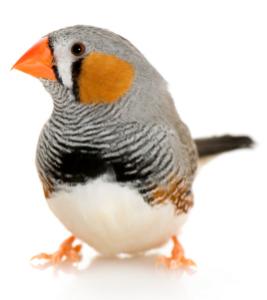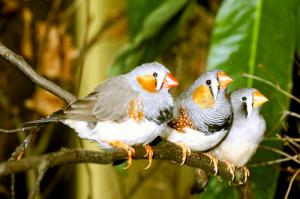
Zebra Finches (Taeniopygia guttata)
Zebra Finches (Taeniopygia guttata also Poephila guttata) are one of the most commonly kept finch species. They are good pet birds for the beginning finch keeper because they are easy to keep in captivity. They belong to the family Estrildidae and the order Passeriformes. Zebra Finches are originally from Australia, but the finches you see in pet stores have been bred in captivity.
Zebra finches are small birds, reaching an adult size of approximately 4 inches (10 cm). For information about their housing and basic care requirements please see the article on Keeping and Caring for Small Finches.
Zebra Finches are peaceful birds that can be successfully housed with other small, peaceful finches and birds, including parakeets.
Sexing Your Zebra Finches
Zebra finches are sexually dimorphic, meaning that you can easily distinguish males from females. The males have more vivid coloration than the females. The males have orange patches on their cheeks and their beaks are a darker color than the females, and the males usually have more black markings on their chest. The males also generally have orange and white markings on their sides, which is not seen in the females. There are some zebra finch strains that are not as sexually dimorphic as the wild type, because their color has been removed through selective breeding (e.g., white zebra finches) and so it is harder to tell the males from females.

In the above photo of the group of three zebra finches you will see two male zebra finches and one female. Notice how much more vividly colored the two males are compared to the female.
The Zebra Finch Song
Because it is much easier to let you hear what the finch song sounds like I've included a You Tube video of a male and female finch singing instead of trying to describe the sound to you.
Can You Tame Zebra Finches?
Mostly, zebra finches cannot be tamed. This is also true for society finches. Birds that are hand fed are more likely to be tame, otherwise, don't expect your finches to warm up to you no matter how many times they see you bringing food to them or cleaning their cage.
That's what makes the bird in the following You Tube video so special. She is a tame zebra finch!
I think this might be my all-time favorite You Tube video! Kudos to Eileen/Guyleen's "surrogate parents" for successfully hand raising him to adulthood!
The only reason that Guyleen is so tame is because of the circumstances of his upbringing. I guess this proves that it isn't only nature, but there is a lot to be said for the influence of one's environment, especially in the formative years.
I recently received an e-mail from Robert Zollna, the person who took such great care of Eileen/Guyleen and made the cute video above. He asked me to include the following advice
on keeping tame finches:
"Unlike untame finches, a tame finch should either be kept alone or only with other tame finches. If kept alone it should be
interacted with at least a few hours a day, because finches, being such a social bird, us humans will have to replace the flock.
If kept with other tame finches they still need lots of attention and to be watched carefully. Even then I would not put more than 3 together
or else they will start to go wild. Of course tame finches are so rare that that is usually not a problem.
A tame finch should never be put with untamed finches, they will kill it within hours."
Thank you Robert for the great advice and for making the cute video of Eileen/Guyleen, not to mention taking such good care of him. Guyleen certainly turned out to be a really sweet little bird! That picture of Guyleen in the Christmas tree is priceless!
Should You Let Your Finches Fly Free?
Not normally, no. The reason Guyleen from the video was able to fly free was because of his tameness and because he was used to being out since he was just a little bird.
Most literature on zebra finches will discourage you from letting your birds fly free. Unfortunately, small birds like finches will often injure themselves when they are out of the cage. It is usually best and safest to buy a large cage that allows your finches some flying room within their cage.
If you do decide to let your finches fly free please be sure that your birds can't escape and that your birds can't hurt themselves on anything. Also, if you intend to allow your zebra finches to fly free then be sure to cover up the windows with drapes or curtains so that your finches don't run into the window and hurt themselves. We know that the clear glass represents a window, but your finch probably won't realize this.
Breeding Zebra Finches
If you intend to breed your zebra finches make sure that you know what you are going to do with the babies after they hatch. Not all pet stores will take zebra finches off your hands and don't necessarily trust your friends to take proper care of your surplus pet birds (unless you know that they will because they are responsible pet owners).
Nests
Zebra Finches are nest sleepers (as opposed to perch sleepers). This means that your zebra finches will prefer to sleep in a nest. However, if you have a male/female zebra finch pair and you don't want them to breed then removing the nest will prevent breeding behaviors.
An alternative is to remove their eggs and replace them with "fake" eggs, which can usually be purchased at the pet store. However, it is best not to include a nest and encourage breeding behavior in very young finches. Most finches that you find in the pet store are young and so it best to wait until they are about a year old before letting them breed.
Another alternative is to house your male and female finches separately until you are ready for them to breed. However, if you do this you must still have at least 2 birds per cage - finches don't thrive as solitary birds.
Although most finches aren't real picky about their mates, it is often best to have a group of finches (an even number of finches is best) and to let them select their own mate. That is, if you have the room. Don't overcrowd your zebra finches.
You can buy commercially prepared nests for your finches at the pet store. These should be enclosed nests with a small opening for the birds to enter and exit. Hang the nest from the top of the cage. You will need a nest (or even better - two nests) per pair of zebra finches. You will also need to provide some nesting material. You can find this at the pet store as well.
When your zebra finches are ready to breed, the male will court the female though song and display rituals. If the female is interested then the male will start gathering nesting materials and the female will help to arrange these materials in the nest. The female will begin laying eggs until she has between 4-6 eggs in the nest.
The male and female zebra finch take turns sitting on the eggs and keeping them warm. The eggs usually hatch in about a week and a half.
The parent zebra finches will take turns gagging up food to feed to the hatchlings.
In about 6-7 weeks later the baby zebra finches will be ready to move to a cage of their own. Be sure to have this ready for them when the time comes.
